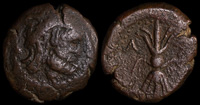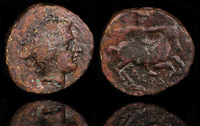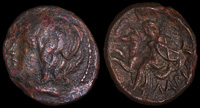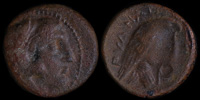Red
View All Tags
The primary chemical process behind this coloration is the oxidation of copper. In the presence of oxygen, copper reacts to form copper(I) oxide (Cu₂O), which appears red. Over time, as the oxidation process continues and the coin is exposed to different environmental conditions such as acids, moisture, and pollutants, this oxide layer may turn to copper(II) carbonate (CuCO₃), which can appear as a duller greenish or reddish hue, depending on the conditions. In some cases, the red color could also be due to the formation of copper(II) sulfate (CuSO₄), which can develop if the coin is exposed to sulfur compounds in the atmosphere.
Other environmental factors can contribute to the reddish patina. Acidic conditions—for example, when coins are buried in soil rich in organic materials or certain minerals—accelerate the corrosion process, and may enhance the formation of copper salts. Saltwater exposure, such as coins being submerged in the sea or coastal environments, may also result in the development of reddish or rust-like coatings, as chlorides and sulfates interact with the metal.
In addition to these environmental conditions, the presence of alloy elements in the coin, such as tin or zinc in bronze, can affect the nature of the corrosion products, possibly leading to different colors. For example, bronze coins (made from a copper-tin alloy) may exhibit a more varied coloration, with green, brown, and red tones appearing as part of the natural aging and oxidation process.

Axos, Crete 3rd-2nd cent BCE

Derdas II ca 380 BCE

Larissa Kremaste 302-286 BCE

Pydna, Macedonia 381-369 BCE
